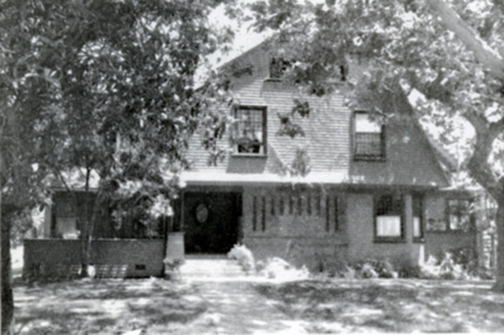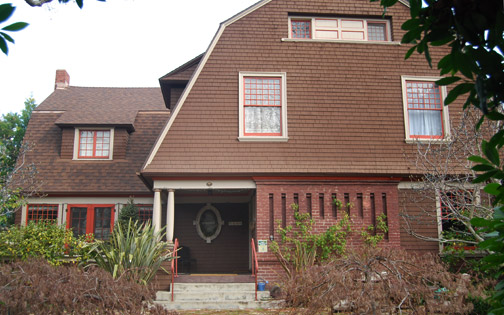 Palo Alto Stanford Heritage
Palo Alto Stanford Heritage |
 |
| Inventory photo taken in 1978 | Photo taken 2010. |
The following is from the Centennial Buildings Tour, prepared by The City of Palo Alto Historic Resources Board for the Centennial Building Celebration, April 16, 1994. The houses included on the tour were all identified as at least 100 years old:
This Colonial Revival/Queen Anne home is thought to be the first house in Palo Alto designed by an architect, presumably Thomas Bender. The massive brick fireplace wall dominates the shingled facade, further graced by small-paned windows and pained porch columns. It was built for Frank Angell, one of Stanford's original faculty and head of the psychology department, and his wife Louise who financed the establishment of Castilleja Hall. Angell was Stanford's first track coach—in 1933 the track oval was dedicated as Angell Field and he was dubbed "Father of Stanford Athletics." It is listed on the Palo Alto Inventory of Historic Houses as a Category 2 (Major Building).
The following is from the Historic Buildings Inventory as revised in 1985:
The massive treatment of the chimney gives remarkable power and presence to this gambrel–roofed Queen Anne/Colonial Revival house. The two–and–a–half story structure is surfaced in shingles. Decorative detailing is provided by the paired porch columns, small-panel windows, and an unusual pattern of tall, this indentations in the facade of the brick–work chimney. The house was extended at one side to provide for the addition of a living room. While the addition concealed the gambrel roof of the other elevation, its treatment and the landscaping disguise the alteration.
This house is an exceptionally powerful version of the Colonial Revival/Queen Anne images. The first floor interior is paneled in redwood and offers four hearths. It is said (Mrs. Hazel Jackson) to be the first house in Palo Alto which was designed by an architect. It was built for Professor Frank Angell, a member of the original Stanford faculty. Angell, who came from Scituate, RI, had been an athlete at the University of Vermont, taught at Cornell for a year, then came to Stanford as head of the Psychology Department. He was the first track coach and chairman of the Committee on Athletics. In 1933, President Ray Lyman Wilbur paid him tribute as the "Father of Stanford Athletics" and Stanford's track oval was dedicated as Angell Field. He retired in 1922 and died in 1938. His wife, Louise, was an active supporter of educational and cultural affairs. She financed the establishment of Castilleja Hall in the 1129 Bryant Street building in 1901, and in 1907 she commissioned Gustav Laumeister to build a shingle–style auditorium nearby at 902 Channing. For several years it provided facilities for schools and occasional traveling performers. It was occupied by First Christian Church in 1917.
After the Angells moved to 1200 Bryant Street in 1905, Mrs. B.B. Towns, a member of a prominent San Francisco family, occupied the house from 1906 to 1925, while her daughters attended the university. Following her were Rufus H. and Katrine F. Kimball. Mrs. Kimball was the daughter of Professor Henry and Frederica Fairclough of Stanford. Kimball, an attorney, was the son of Corabelle Kimball, who commissioned the building of several Professorville houses at the beginning of the century. The Kimballs occupied the house until 1940. After a short interval it became the home of David A. and Hazel Jackson, who recently had come to the city. Jackson was an employee of F.W. Woolworth. The Jacksons lived in the house from 1948 to 1958. Several tenants occupied it in the 1960s and the present [1979, Robert and Joan Jack] owners acquired it circa 1968 and lived there until October, 2008.
Location map Robert Brandeis photo
This house was built in 1893 and is a Category 2 on the Historic Buildings Inventory. The architect may have been Thomas Bender and the builders were Z.O. Field (listed as architect) and Francis K. Ledyard. This home has been part included in Holiday House Tours in 1988, 1993 and 2010. The property measures 75 by 90 (+27) feet.
Sources: Palo Alto City Directories; Palo Alto Times1/5/94, 6/25/97, 9/13/12, 3/14/17, 1/19/37, 9/4/39; AAUW, ...Gone Tomorrow?; Historic House Tour, Valley of Santa Clara; see P. A. Live Oak 10/20/97 , 1/1/00 and P. A. Times 5/2/06 for early photos.
| |
E-mail us at either webmaster@pastheritage.org or president@pastheritage.org.
![]() Palo Alto Stanford Heritage—Dedicated to the preservation of Palo Alto's historic buildings.
Palo Alto Stanford Heritage—Dedicated to the preservation of Palo Alto's historic buildings.
Copyright © 2015 Palo Alto Stanford Heritage. All rights reserved.